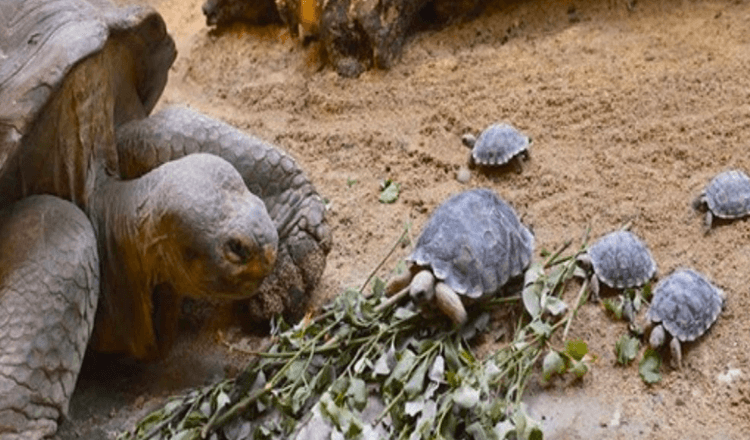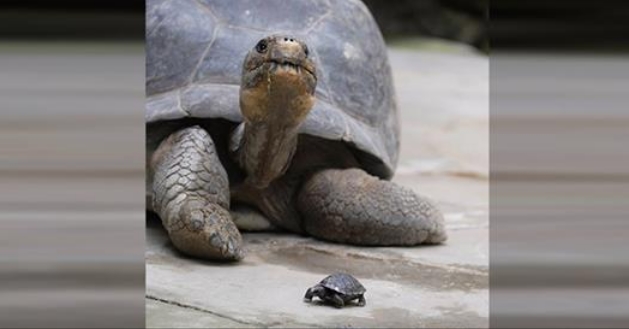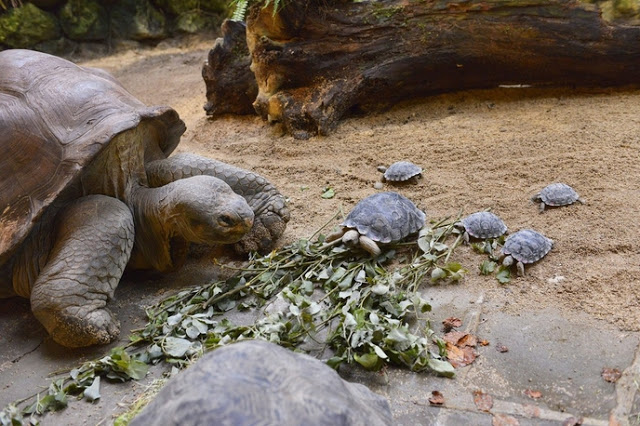
First time mother – Whereas most of animal species don’t even stay as much as 80-year-old, for Nigrita – the tortoise, it’s the age she gave start for the very first time. An much more lucky occasion pondering her species is endangered.

Nigrita is an 80-year-old Galapagos tortoise that lives on the Zoo Zürich in Switzerland.

Native to the islands with the identical identify, the Galapagos tortoise are the most important tortoise species, weighing as much as 900lb. They’re additionally capable of stay greater than 150 years. Sadly, again within the 70s, the species was on the verge of extinction with solely ten people left within the wild.
She additionally occurs to be making a giant distinction for her endangered species

Nigrita laid her first eggs this 12 months. Most species don’t stay to be 80 years previous, not to mention give start at that age, however for her species, it’s fairly regular!

The truth is, these tortoises sometimes don’t begin reproducing till round age 40. Galapagos tortoises are referred to as one of many longest-living animals on Earth. By tortoise requirements, Nigrita is in her prime.
Though Galapagos tortoises can stay to be over 150 years previous, there aren’t many left. The species is endangered on account of grasping people and hungry predators.
Nigrita is at present a part of a breeding program on the zoo, which makes her 9 hatchlings all of the extra particular. It’s as much as tortoises like Nigrita to make sure the survival of her species.
Watch the dear video beneath:


First time mother – Whereas most of animal species don’t even stay as much as 80-year-old, for Nigrita – the tortoise, it’s the age she gave start for the very first time. An much more lucky occasion pondering her species is endangered.

Nigrita is an 80-year-old Galapagos tortoise that lives on the Zoo Zürich in Switzerland.

Native to the islands with the identical identify, the Galapagos tortoise are the most important tortoise species, weighing as much as 900lb. They’re additionally capable of stay greater than 150 years. Sadly, again within the 70s, the species was on the verge of extinction with solely ten people left within the wild.
She additionally occurs to be making a giant distinction for her endangered species

Nigrita laid her first eggs this 12 months. Most species don’t stay to be 80 years previous, not to mention give start at that age, however for her species, it’s fairly regular!

The truth is, these tortoises sometimes don’t begin reproducing till round age 40. Galapagos tortoises are referred to as one of many longest-living animals on Earth. By tortoise requirements, Nigrita is in her prime.
Though Galapagos tortoises can stay to be over 150 years previous, there aren’t many left. The species is endangered on account of grasping people and hungry predators.
Nigrita is at present a part of a breeding program on the zoo, which makes her 9 hatchlings all of the extra particular. It’s as much as tortoises like Nigrita to make sure the survival of her species.
Watch the dear video beneath:

What 5 traits do all animals have in widespread?
What 5 traits do all animals have in widespread?
Within the following slides, we’ll discover the fundamental traits shared by all (or at the least most) animals, from snails and zebras to mongooses and sea anemones: multicellularity, eukaryotic cell construction, specialised tissues, sexual copy, a blastula stage of growth, motility, heterotrophy and possession …
What traits do all animals have in widespread quizlet?
The six traits that each one organisms within the animal kingdom share are: they’re multicellular, nearly all can transfer, their cells don’t have any cell wall, they must hunt for their very own meals (customers), they’re eukaryotic, reproduce sexually-when two cells be part of to type off spring and their cells lack chloroplasts.
What 4 traits do all animals share?
Most animals share these traits: sensory organs, motion, and inside digestion. All of them are illustrated in Determine beneath. Animals can detect environmental stimuli, equivalent to mild, sound, and contact. Stimuli are detected by sensory nerve cells.
What are the 7 traits of all animals?
- 1 Vitamin. Residing issues absorb supplies from their environment that they use for development or to supply vitality.
- 2 Respiration.
- 3 Motion.
- 4 Excretion.
- 5 Progress.
- 6 Replica.
- 7 Sensitivity.
What are the 6 traits widespread to all animals?
They’re as follows:
- All animals are made up of cells that do not need cell partitions.
- All animals are multicellular organisms.
- Most animals reproduce sexually.
- All animals are able to self-propelled movement in some unspecified time in the future of their lives.
- All animals are heterotrophic and should devour different organisms for vitality.
What protein do all animals have in widespread?
The exctracellular protein collagen (making probably the most considerable extracellular protein in animals) which is required in multicellular organisms to maintain the cells collectively, which is unique to animals. Most enzymes liable for metabolic pathways.
What are the three traits of animals?
Traits of Animals
- Animals are multicellular organisms.
- Animals are eukaryotic.
- Animals are heterotrophic.
- Animals are typically motile.
- Animals possess specialised sensory organs equivalent to eyes, ears, nostril, pores and skin, and tongue.
- Animals reproduce sexually.
What are the fundamental traits of all animals?
Within the following slides, we’ll discover the fundamental traits shared by all (or at the least most) animals, from snails and zebras to mongooses and sea anemones: multicellularity, eukaryotic cell construction, specialised tissues, sexual copy, a blastula stage of growth, motility, heterotrophy and possession of a complicated nervous system.
What do all animals have in widespread with one another?
Sexual copy is one other attribute shared by most, however not all, animals. No matter species, all animals share multicellularity, which suggests their our bodies encompass a number of cells. This units animals other than organisms, equivalent to single-celled algae, fungi, micro organism and different fundamental life varieties.
What do vegetation and animals have in widespread?
Most vegetation are additionally multicellular, so though this can be a attribute shared by all animals, it’s not one distinctive to animals.Each animal on the planet is a eukaryote. A eukaryote is an organism that consists of cells which have membrane-bound nuclei and organelles.
What are the traits of the animal kingdom?
All animals are eukaryotic, multicellular organisms, and most animals have complicated tissue construction with differentiated and specialised tissue. Animals are heterotrophs; they need to devour dwelling or useless organisms since they can’t synthesize their very own meals and may be carnivores, herbivores, omnivores, or parasites.



